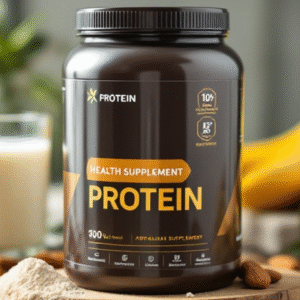
Building muscle after 40 may seem challenging, but with the right approach, it’s entirely achievable. As we age, our bodies undergo changes that can affect muscle mass and strength. However, with a tailored fitness plan, proper nutrition, and a focus on recovery, you can effectively build and maintain muscle.
Understanding the Challenges
After 40, muscle mass naturally begins to decline due to hormonal changes and a decrease in physical activity. This process is known as sarcopenia. Sarcopenia can lead to a reduction in muscle strength and function, impacting overall quality of life. To combat this, it’s essential to incorporate strength training, adequate protein intake, and recovery strategies into your routine.
Effective Strategies for Muscle Building
Strength Training
Engage in resistance training exercises at least 2-3 times a week. Focus on compound movements like squats, deadlifts, and bench presses to target multiple muscle groups and stimulate muscle growth. Here are some key points to consider:
- Compound Movements: These exercises work multiple muscle groups simultaneously, making them highly effective for building muscle. Examples include squats, deadlifts, bench presses, and pull-ups.
- Isolation Exercises: While compound movements are crucial, incorporating isolation exercises like bicep curls and tricep extensions can help target specific muscles and improve overall muscle balance.
- Variety: Change your exercises periodically to prevent plateaus and keep your workouts interesting. This can include using different equipment, such as dumbbells, barbells, resistance bands, and machines.
Progressive Overload
Gradually increase the weight or resistance in your workouts to challenge your muscles and promote growth. Keep track of your progress and adjust your routine accordingly. Here are some tips for implementing progressive overload:
- Increase Weight: Gradually add more weight to your exercises as you become stronger. Aim for small increments to avoid injury.
- Increase Repetitions: If increasing weight isn’t feasible, try adding more repetitions to your sets.
- Increase Sets: Adding more sets to your workout can also help increase the overall volume and intensity.
- Vary Tempo: Changing the speed at which you perform exercises can add a new challenge and stimulate muscle growth.
Adequate Protein Intake
Consume sufficient protein to support muscle repair and growth. Aim for 1.2 to 1.6 grams of protein per kilogram of body weight daily. Include sources like lean meats, fish, eggs, dairy, and plant-based proteins. Here are some tips for optimizing protein intake:
- Protein Timing: Distribute your protein intake evenly throughout the day to maximize muscle protein synthesis. Aim for 20-30 grams of protein per meal.
- Post-Workout Nutrition: Consuming protein after your workout can help kickstart the recovery process. Consider a protein shake or a meal with lean protein and carbohydrates.
- High-Quality Sources: Choose high-quality protein sources that provide all essential amino acids. Examples include chicken, turkey, fish, eggs, dairy products, beans, lentils, and tofu.
Prioritize Recovery
Allow your muscles time to recover by incorporating rest days into your routine. Adequate sleep and stress management are also crucial for muscle recovery and overall well-being. Here are some recovery strategies:
- Rest Days: Schedule at least one or two rest days per week to allow your muscles to repair and grow.
- Sleep: Aim for 7-9 hours of quality sleep per night. Sleep is essential for muscle recovery and overall health.
- Active Recovery: Engage in low-intensity activities like walking, yoga, or stretching on rest days to promote blood flow and reduce muscle soreness.
- Stress Management: Practice stress-reducing techniques like meditation, deep breathing, or spending time in nature to support overall well-being.
Flexibility and Mobility
Incorporate stretching and mobility exercises to maintain joint health and prevent injuries. Yoga and Pilates can be excellent additions to your routine. Here are some tips for improving flexibility and mobility:
- Dynamic Stretching: Perform dynamic stretches before your workouts to warm up your muscles and improve range of motion.
- Static Stretching: Incorporate static stretches after your workouts to enhance flexibility and reduce muscle tension.
- Foam Rolling: Use a foam roller to release muscle tightness and improve mobility.
- Yoga and Pilates: These practices can help improve flexibility, balance, and core strength, which are essential for overall fitness.
Stay Consistent
Consistency is key to building muscle at any age. Stick to your workout plan and make adjustments as needed to keep progressing. Here are some tips for staying consistent:
- Set Realistic Goals: Establish achievable goals and break them down into smaller milestones.
- Create a Schedule: Plan your workouts and meals in advance to stay on track.
- Find Support: Join a fitness group or find a workout buddy to stay motivated.
- Stay Positive: Focus on the progress you’ve made rather than the setbacks.
Nutrition Tips for Muscle Building
A balanced diet is crucial for muscle building. Here are some nutrition tips to support your muscle-building goals:
- Balanced Diet: Focus on a diet rich in whole foods, including plenty of fruits, vegetables, whole grains, and healthy fats.
- Hydration: Stay hydrated to support overall health and muscle function. Aim for at least 8-10 glasses of water per day.
- Supplements: Consider supplements like whey protein, creatine, and BCAAs to support your muscle-building goals. Consult with a healthcare professional before starting any new supplements.
- Healthy Fats: Include sources of healthy fats, such as avocados, nuts, seeds, and olive oil, to support hormone production and overall health.
- Carbohydrates: Ensure adequate carbohydrate intake to fuel your workouts and support muscle recovery. Choose complex carbohydrates like whole grains, fruits, and vegetables.
Overcoming Plateaus
If you hit a plateau, consider changing your workout routine, increasing intensity, or adjusting your nutrition. Consulting with a fitness professional can also provide personalized guidance. Here are some strategies for overcoming plateaus:
- Change Exercises: Introduce new exercises or variations to challenge your muscles in different ways.
- Increase Intensity: Add more weight, repetitions, or sets to your workouts to increase the intensity.
- Adjust Nutrition: Ensure you’re consuming enough calories and nutrients to support muscle growth. Consider tracking your food intake to identify any gaps.
- Rest and Recovery: Sometimes, a plateau can be a sign that your body needs more rest. Ensure you’re allowing adequate recovery time between workouts.
Additional Tips for Building Muscle After 40
- Focus on Form: Proper form is essential to prevent injuries and maximize the effectiveness of your workouts. Consider working with a personal trainer to ensure you’re using the correct technique.
- Listen to Your Body: Pay attention to how your body feels and adjust your workouts accordingly. If you experience pain or discomfort, take a break and consult with a healthcare professional if needed.
- Stay Active Throughout the Day: Incorporate more movement into your daily routine, such as taking the stairs, walking during breaks, or doing household chores.
- Monitor Your Progress: Keep track of your workouts, diet, and measurements to see how far you’ve come and make adjustments as needed.
- Stay Informed: Stay up-to-date with the latest fitness and nutrition research to ensure you’re using the most effective strategies for muscle building.
Conclusion
Building muscle after 40 is achievable with the right approach. By incorporating strength training, proper nutrition, and recovery strategies, you can effectively build and maintain muscle mass. Stay committed to your fitness journey, and you’ll see the results you’re aiming for. Remember, the journey to building muscle is a marathon, not a sprint. Stay patient, consistent, and positive, and you’ll see the results over time.
Please take a look to our Building Muscle Category: https://titisfitness.com/category/building-muscles/
Please take a look to our high protein meals: https://titisfitness.com/category/meals/






